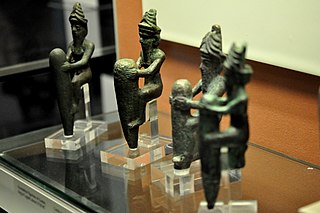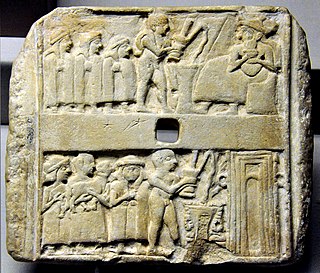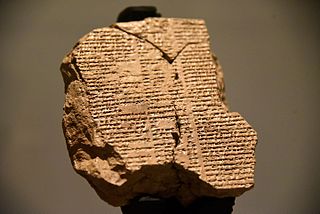
Enlil, later known as Elil, is an ancient Mesopotamian god associated with wind, air, earth, and storms. He is first attested as the chief deity of the Sumerian pantheon, but he was later worshipped by the Akkadians, Babylonians, Assyrians, and Hurrians. Enlil's primary center of worship was the Ekur temple in the city of Nippur, which was believed to have been built by Enlil himself and was regarded as the "mooring-rope" of heaven and earth. He is also sometimes referred to in Sumerian texts as Nunamnir. According to one Sumerian hymn, Enlil himself was so holy that not even the other gods could look upon him. Enlil rose to prominence during the twenty-fourth century BC with the rise of Nippur. His cult fell into decline after Nippur was sacked by the Elamites in 1230 BC and he was eventually supplanted as the chief god of the Mesopotamian pantheon by the Babylonian national god Marduk. The Babylonian god Bel was a syncretic deity of Enlil, Marduk, and the shepherd deity Dumuzid.

Enki is the Sumerian god of water, knowledge (gestú), mischief, crafts (gašam), and creation (nudimmud), and one of the Anunnaki. He was later known as Ea in Akkadian mythology. He was originally patron god of the city of Eridu, but later the influence of his cult spread throughout Mesopotamia and to the Canaanites, Hittites and Hurrians. He was associated with the southern band of constellations called stars of Ea, but also with the constellation AŠ-IKU, the Field. Beginning around the second millennium BCE, he was sometimes referred to in writing by the numeric ideogram for "40", occasionally referred to as his "sacred number". The planet Mercury, associated with Babylonian Nabu was, in Sumerian times, identified with Enki.

Mesopotamia is a historical region of Western Asia situated within the Tigris–Euphrates river system, in the northern part of the Fertile Crescent. It occupies the area of present-day Iraq and Kuwait, and parts of Iran, Syria, and Turkey.

Sumer is the earliest known civilization in the historical region of southern Mesopotamia, emerging during the Chalcolithic and early Bronze Ages between the sixth and fifth millennium BC. It is also one of the first civilizations in the world, along with Ancient Egypt, Norte Chico, the Minoan civilization, and the Indus Valley Civilization. Living along the valleys of the Tigris and Euphrates, Sumerian farmers grew an abundance of grain and other crops, the surplus from which enabled them to form urban settlements. Proto-writing dates back before 3000 BC. The earliest texts come from the cities of Uruk and Jemdet Nasr, and date to between c. 3500 and c. 3000 BC.

Inanna is an ancient Mesopotamian goddess associated with love, beauty, sex, war, justice and political power. She was originally worshiped in Aratta and Sumer under the name "Inanna", and was later worshipped by the Akkadians, Babylonians, and Assyrians under the name Ishtar. She was known as the "Queen of Heaven" and was the patron goddess of the Eanna temple at the city of Uruk, which was her main cult center. She was associated with the planet Venus and her most prominent symbols included the lion and the eight-pointed star. Her husband was the god Dumuzid and her sukkal, or personal attendant, was the goddess Ninshubur.

Mesopotamian religion refers to the religious beliefs and practices of the civilizations of ancient Mesopotamia, particularly Sumer, Akkad, Assyria and Babylonia between circa 3500 BC and 400 AD, after which they largely gave way to Syriac Christianity. The religious development of Mesopotamia and Mesopotamian culture in general, especially in the south, was not particularly influenced by the movements of the various peoples into and throughout the area. Rather, Mesopotamian religion was a consistent and coherent tradition which adapted to the internal needs of its adherents over millennia of development.

Utu, later worshipped by the East Semitic Akkadian-speaking Babylonians as Shamash, was the ancient Mesopotamian sun god, god of justice, morality, and truth, and the twin of the Mesopotamian goddess Inanna, the Queen of Heaven. His main temples were in the cities of Sippar and Larsa. He was believed to ride through the heavens in his sun chariot and see all things that happened in the day. He was the enforcer of divine justice and was thought to aid those in distress. According to Sumerian mythology, he helped protect Dumuzid when the galla demons tried to drag him to the Underworld and he appeared to the hero Ziusudra after the Great Flood. In the Epic of Gilgamesh, he helps Gilgamesh defeat the ogre Humbaba.

In Mesopotamian mythology, Ereshkigal was the goddess of Kur, the land of the dead or underworld in Sumerian mythology. In later East Semitic myths, she was said to rule Irkalla alongside her husband Nergal. Sometimes her name is given as Irkalla, similar to the way the name Hades was used in Greek mythology for both the underworld and its ruler, and sometimes it is given as Ninkigal, lit. "Lady of the Great Earth".

The Anunnaki are a group of deities of the ancient Sumerians, Akkadians, Assyrians, and Babylonians. In the earliest Sumerian writings about them, which come from the Post-Akkadian period, the Anunnaki are the most powerful deities in the pantheon, descendants of An and Ki, the god of the heavens and the goddess of earth, and their primary function was to decree the fates of humanity. Since the second half of the twentieth century, they have been the subject of new, upcoming Modern Archaeologists and Sumerian translators, such as Irving Finkel.

Atra-Hasis [Atra-ḫasīs] is an Akkadian epic, recorded in various versions on clay tablets, named for its protagonist, Atrahasis. The Atra-Hasis tablets include both a creation myth and one of three surviving Babylonian flood myths. The name "Atra-Hasis" also appears, as king of Shuruppak in the times before a flood, on one of the Sumerian King Lists.

In Sumerian religion, Ninlil, also called Sud, in Assyrian called Mulliltu, is the consort goddess of Enlil. Her parentage is variously described. Most commonly she is called the daughter of Nunbarsegunu and Haia. Another Akkadian source says she is the daughter of Antu and Anu. Other sources call her a daughter of Anu and his mother, Nammu.

Babylonian religion is the religious practice of Babylonia. Babylonian mythology was greatly influenced by their Sumerian counterparts and was written on clay tablets inscribed with the cuneiform script derived from Sumerian cuneiform. The myths were usually either written in Sumerian or Akkadian. Some Babylonian texts were translations into Akkadian from the Sumerian language of earlier texts, although the names of some deities were changed.

The Gilgamesh flood myth is a flood myth in the Epic of Gilgamesh. Many scholars believe that the flood myth was added to Tablet XI in the "standard version" of the Gilgamesh Epic by an editor who used the flood story from the Epic of Atrahasis. A short reference to the flood myth is also present in the much older Sumerian Gilgamesh poems, from which the later Babylonian versions drew much of their inspiration and subject matter.
The earliest record of a Sumerian creation myth, called The Eridu Genesis by historian Thorkild Jacobsen, is found on a single fragmentary tablet excavated in Nippur by the Expedition of the University of Pennsylvania in 1893, and first recognized by Arno Poebel in 1912. It is written in the Sumerian language and dated to around 1600 BCE. Other Sumerian creation myths from around this date are called the Barton Cylinder, the Debate between sheep and grain and the Debate between Winter and Summer, also found at Nippur.

Anu, Anum, or Ilu, also called An, is the divine personification of the sky, supreme god, and ancestor of all the deities in ancient Mesopotamian religion. Anu was believed to be the supreme source of all authority, for the other gods and for all mortal rulers, and he is described in one text as the one "who contains the entire universe". He is identified with the north ecliptic pole centered in the constellation Draco and, along with his sons Enlil and Enki, constitutes the highest divine triad personifying the three bands of constellations of the vault of the sky. By the time of the earliest written records, Anu was rarely worshipped, and veneration was instead devoted to his son Enlil, but, throughout Mesopotamian history, the highest deity in the pantheon was always said to possess the anûtu, meaning "Heavenly power". Anu's primary role in myths is as the ancestor of the Anunnaki, the major deities of Sumerian religion. His primary cult center was the Eanna temple in the city of Uruk, but, by the Akkadian Period, his authority in Uruk had largely been ceded to the goddess Inanna, the Queen of Heaven.

Sumerian religion was the religion practiced and adhered to by the people of Sumer, the first literate civilization of ancient Mesopotamia. The Sumerians regarded their divinities as responsible for all matters pertaining to the natural and social orders.
There are many references to ghosts in ancient Mesopotamian religion – the religions of Sumer, Babylon, Assyria and other early states in Mesopotamia. Traces of these beliefs survive in the later Abrahamic religions that came to dominate the region.

The work known by its incipit, Angim, "The Return of Ninurta to Nippur", is a rather obsequious 210-line mythological praise poem for the ancient Mesopotamian warrior-god Ninurta, describing his return to Nippur from an expedition to the mountains (KUR), where he boasts of his triumphs against "rebel lands" (KI.BAL), boasting to Enlil in the Ekur, before returning to the Ešumeša temple – to “manifest his authority and kingship.”

Mesopotamian mythology refers to the myths, religious texts, and other literature that comes from the region of ancient Mesopotamia in modern-day West Asia. In particular the societies of Sumer, Akkad, and Assyria, all of which existed shortly after 3000 BCE and were mostly gone by 400 CE. These works were primarily preserved on stone or clay tablets and were written in cuneiform by scribes. Several lengthy pieces have survived, some of which are considered the oldest stories in the world, and have given historians insight into Mesopotamian ideology and cosmology.

The ancient Mesopotamian underworld, most often known in Sumerian as Kur, Irkalla, Kukku, Arali, or Kigal and in Akkadian as Erṣetu, although it had many names in both languages, was a dark, dreary cavern located deep below the ground, where inhabitants were believed to continue "a shadowy version of life on earth". The only food or drink was dry dust, but family members of the deceased would pour libations for them to drink. Unlike many other afterlives of the ancient world, in the Sumerian underworld, there was no final judgement of the deceased and the dead were neither punished nor rewarded for their deeds in life. A person's quality of existence in the underworld was determined by his or her conditions of burial.














